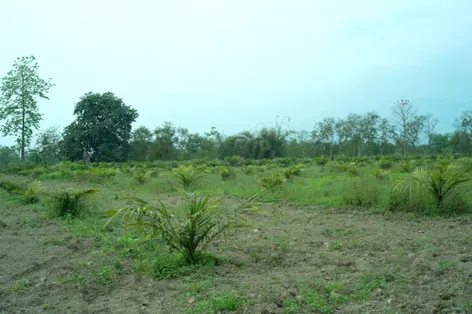
[ Bikash Kumar Bhattacharya ]
Over the past seven years, Takali Tamuk, a farmer and agro-entrepreneur from Pasighat in East Siang district has attended several outreach programmes on oil palm cultivation. These were organised as part of the Indian government’s push to promote the crop in the state. Like many others in the region, he adopted oil palm, but with studied caution: he planted the new crop only on a small plot of land to test its suitability to local soil and climate.
While his palm trees grow promisingly, and some have even taken to fruiting, Tamuk doubts the crop’s successful introduction in the state and says he has “lost all hope that the crop will take off in the state, unless a robust supply chain is created.”
Today, Arunachal Pradesh reportedlyu has over 3,000 hectares of standing oil palm cultivation. However, it still does not have a processing mill. The oil palm companies promoting the crop in Arunachal refuse to ship the fruits to a crushing mill located outside the state, citing lack of produce to make the venture commercially viable. The oil palm fruit is highly perishable and has to be processed within 48 hours of harvesting, or it begins to deteriorate, with harmful fatty acids building up.
Oil palm companies often leave the fruits on the farms after purchase, and according to the farmers, till date, no fruit from the state has been processed.
According to an agreement between the government and the oil palm companies in the state, the farmers are paid for their harvest – even if the fruits are only left to decompose – albeit the price they are offered is by no means competitive. The Ruchi Soya Oil Palm company, which operates in East Siang district, pays the farmers about Rs 8 per kg, while 3F Oil Palm in Lower Dibang Valley district paid Rs 7 per kg for oil palm fruits in 2021.
“If oil palm fruit processing mills are not established in the state soon, this (oil palm cultivation) is not going to go a long way. The farmers are losing hope and patience,” says Tamuk.
In September 2021, Arunachal’s Chief Minister Pema Khandu, a supporter of oil palm cultivation, admitted in a conference on agriculture in Northeast India that failing to set up processing factories had led to loss of confidence among oil palm pioneers in the state.
Oil palm in Arunachal
The northeastern state’s foray into oil palm cultivation started in 2012 with 3F Oil Palm establishing an oil palm nursery in Lower Dibang Valley.
In East Siang, the plantations started in 2014, with Ruchi Soya setting up a nursery. Now, India’s national mission to increase domestic production of palm oil, particularly in Northeast India, which will help reduce imports from Malaysia and Indonesia, is expected to provide a fillip to the crop’s expansion in the biodiversity-rich state.
In 2014, the state government passed the Arunachal Pradesh Oil Palm (Production and Processing) Regulation, 2014 – modelled largely on the Mizoram Oil Palm (Regulation of Production and Processing) Act, 2004 – setting up the guidelines for the promotion of the crop in the state. The policy mandates that farmers in a ‘factory zone’ – the area covered by a particular processing company – sell their produce only to the allotted mill, paving the way for what are known as “captive plantations.”
According to the policy, East Siang and Lower Dibang Valley districts have been assigned as ‘factory zones’ to Ruchi Soya Oil Palm and 3F Oil Palm company, respectively.
Other districts chosen for the expansion of the crop in the state include Namsai, Changlang, Tirap, East Kameng, Papum Pare, Lower Subansiri and West Siang.
In 2021, Tawang, a remote mountainous district with an annual average temperature of 10.3 degrees Celsius, was also identified as a potential site for oil palm, a tropical plant adapted to temperatures between 22 to 32 degrees Celsius.
In 2018, the Arunachal government introduced a new land settlement regulation that, for the first time, conferred land property rights to individuals in a state where most of the lands are customarily owned by communities. The passing of this regulation eased the process of land acquisition for investors in the state, including oil palm companies, as the legislation permitted native individuals to lease out lands to non-native businesses.
Backed by this new land bill, both 3F Oil Palm and Ruchi Soya are reportedly in the process of acquiring land for setting up oil palm processing factories.
However, Tamuk and other oil palm growers Mongabay-India spoke to say that they have been hearing about the plans to establish factories for more than five years and will believe it only when the plans are materialised.
Why did some farmers see promise in oil palm?
When oil palm was introduced in the state, a few farmers were enthusiastic about the new crop. Agro-entrepreneur Dature Miuli and his wife Sipa Mena Miuli of Roing in Lower Dibang Valley were among them. They have planted oil palm on a 200-hectare agricultural plot they own in Rukmo village, in Lower Dibang Valley district. Until six years ago, they used to plant maize, mustard seeds, ginger and buckwheat on it.
Sipa Mena Miuli told Mongabay-India that despite plentiful yields in these traditional crops from her fields in Bhismaknagar in Lower Dibang Valley, she does not make good profits as the government does not mandate a minimum price for her crops.
“The middlemen who buy the produce at a very low price are the ones who reap the benefits,” she says. “It is the absence of a stable market price for traditional crops like mustard seeds, maize and vegetables that is pushing people here to try any new crop, whenever the government promises a stable market for it.”
“The reason behind us adopting palm oil was that the government and the oil palm company promised us a steady market for the crop,” says Dature Miuli. “But they are offering us a mere Rs 7 per kg oil palm fruits, which is far from being competitive price. We can barely manage to pay the expense of the fertilisers.”
He further says that the company leaves the purchased oil palm fruits on his farm only to rot, as there is no processing mill, and some farms are located so far away from motorable roads that commuting there is a difficult task.
If oil palm is to take off in the state, they will need a mill, a stable market and better road networks connecting the remote oil palm farms, Dature Miuli adds. “Only providing subsidies to farmers will not help in the long run.”
Jatropha and cardamom deja vu for oil palm growers
In the 2000s, many governments across the globe promoted jatropha (Jatropha curcas) plantation through various schemes. In India, with its increasing demand for fuel, the plant became central to ‘wasteland’ development plans. A native to the American tropics, jatropha is an extremely hardy plant that grows in places where most plants would die: on degraded and dry plots. The seeds of the plant can be processed into lesser polluting biodiesel.
However, the jatropha boom did not last long, not only in India but also globally, owing to speculations based on a misunderstanding of the plant. While the plant would grow on wastelands, it still needed plenty of water and nutrients to produce enough seeds to make the plantations commercially viable.
Kamal Nandan Sinha, a biofuel consultant and former manager at the natural gas distribution company D1 Williamson Mago Biofuel, says that most farmers who adopted the crop felt cheated by the government after the unrealistic returns promised, turned out to be flawed. D1 Williamson Magor Biofuel managed a number of jatropha plantations in Arunachal.
“Farmers were lured to plant jatropha with unrealistic profit projections and when things did not work out, most farmers abandoned the plantations,” he tells Mongabay-India. “There have been reports of locally influential individuals charging fees to enable poor tribal farmers to take up bank loans, in order to set up jatropha plantations.”
Some farmers, he says, are still struggling to pay back their loans.
Tam Tayo, a former jatropha farmer from Balijan, said that he was promised a produce of over 800 gram seeds per plant but he got only around 250 to 300 grams.
“There was no one to buy the produce. The market I was promised was simply nonexistent. I lost all my investment,” Tayo said.
A 2014 policy brief by the South Asian Network for Development and Environmental Economics (SANDEE) on the promotion of jatropha in the region corroborates to some of these claims.
A few years ago, the local government touted cardamom (Amomum subulatum) – badi elaichi — as the next big cash crop in the state and encouraged farmers to cultivate the spice. Many farmers heeded to this call and reaped considerable success in the initial years.
However, this was only short-lived, says Tagum Jamoh, a lawyer and agro-entrepreneur from Siang district. “The buyers, who come from outside Arunachal Pradesh, often form a syndicate to procure the cardamom produce at a rate way below the market price, sometimes as low as Rs 50 per kg, prompting some farmers to uproot their cardamom plants,” says Jamoh.
In 2020, Tage Taki, the state’s agriculture minister, stated that the price of large cardamom has declined to Rs 450 per kg from an average price of Rs 1,300 per kg in 2014-15, owing to market fluctuations beyond the control of the Arunachal Pradesh government. He further said that, as a perishable agro-product, “cardamom doesn’t come within the policy of MSP [minimum support price]” and as such, growers of the crop remain unprotected against market vulnerability.”
Oil palm pioneers in the state are now starting to see parallels with the failed projects of jatropha and cardamom. While the growth of the oil palm plant has been promising in certain areas in the state, the farmers fear that the ‘factory zone’ rules will potentially lead to monopoly over the rates, in case the oil palm market takes off.
Dature Miuli says that if he did not have an agreement with 3F Oil Palm, he would not have been able to sell any of his produce, as currently there is no local market for oil palm. “But the scheme could prove counterproductive in the long run. As farmers can sell their produce only to the company in charge of the concerned factory zone according to the agreement, we will not have access to the free market,” he says. “This means, the company will have the leeway to control the rates, something similar to what the cardamom farmers in the state have been facing at the moment,” he adds. (This article was originally published by Mongabay-India.)





